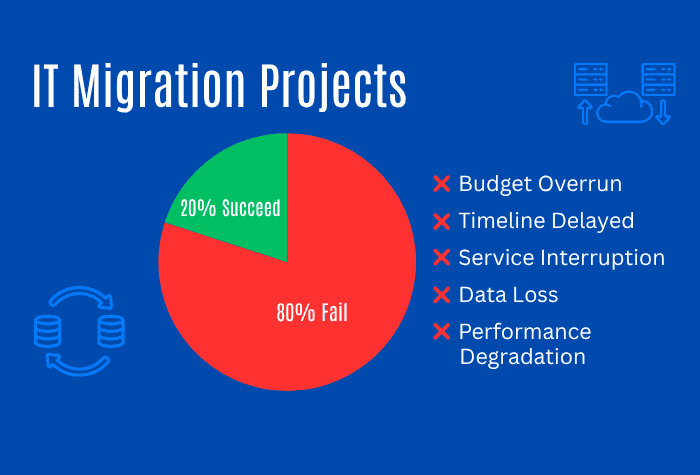Why 80% of IT Migrations Fail
BY CTM TECHNOLOGY GROUP | BLOG

BY CTM TECHNOLOGY GROUP | BLOG

IT migrations whether to the cloud, a new data center, or updated infrastructure are a strategic necessity for modern enterprises. Yet despite their importance, they remain one of the most failure-prone initiatives in technology. According to industry reports, up to 80% of IT migrations fail to meet expectations. Whether due to missed deadlines, unexpected costs, or operational disruptions, these failures can cause more than just frustration, they can damage customer trust, employee productivity, and the business’s bottom line.
So why do most migrations go wrong and more importantly, how can your organization be among the successful 20%?
Let’s explore the most common pitfalls and the practical steps you can take to avoid them.
Before diving into the reasons behind failure, it’s important to understand what failure means in the context of IT migration. A migration project may be considered a failure if it:
A failed migration can cost hundreds of thousands or even millions of dollars. For highly regulated industries like healthcare, finance, or pharmaceuticals, the stakes are even higher due to compliance risks.
Migration is often treated as a technical task, not a business-critical initiative. Without a clear strategy that aligns with business goals, teams can fall into reactive decision-making. This often leads to scope creep, missed dependencies, and inefficiencies.
You can’t move what you don’t fully understand. Many organizations lack current, accurate inventories of their IT environments. Without visibility into applications, data flows, and dependencies, migrations often overlook critical interconnections leading to outages and failed cutovers.
IT environments are rarely simple. Custom integrations, legacy systems, and overlapping technologies make migration a complex process. Underestimating that complexity, especially during early assessments leads to inaccurate timelines and surprises during execution.
Many migrations still rely on manual processes and spreadsheets. Without automation, dependency mapping, and intelligent scheduling, teams are forced to make assumptions. This introduces human error and increases the risk of failure.
Testing is often rushed or skipped due to time constraints. But testing each phase from development to production and failover and rollback is essential to catch problems before migration.
Migrations typically involve multiple teams: infrastructure, networking, application owners, compliance, and external vendors. Without clear communication and collaboration, critical steps get missed and accountability becomes blurred.
Migrations impact users, customers, and the business at large. Projects fail when these stakeholders aren’t informed, trained, or prepared for changes in workflows or system access.
Begin with a comprehensive migration strategy that considers not just the technology, but the business goals. Why are you migrating? What will success look like? Which metrics matter most? Define the scope, schedule, and business impact clearly from the start.
Use tools like AppMap 360 to automate data consolidation, streamline dependency mapping, and build a real-time visual of your IT landscape. This insight allows you to group related workloads, identify hidden risks, and plan migrations based on accurate, up-to-date data.
Dependency mapping is often the single most important step in preventing downstream issues. Automated tools help eliminate the guesswork and speed up analysis.
Large migrations are inherently risky. Breaking them into smaller waves or sprints reduces the blast radius of failure, allows for faster feedback, and builds momentum. This also makes it easier to isolate issues when they arise.
Each wave should include defined success criteria, rollback plans, and retrospectives before moving to the next.
Automation isn’t just a productivity boost it’s a reliability enhancer. Automation ensures consistency, reduces errors, and frees up your team to focus on critical issues.
CTM’s AppMap 360 tool, for instance, streamlines dependency mapping, automates data consolidation, and accelerates migration planning with built-in intelligence.
Testing should be built into every phase. Validate application performance in non-production environments that mirror production. Test failover and rollback procedures. Conduct dry runs. The more comprehensive your testing, the fewer surprises you’ll encounter during cutover.
Create a shared migration playbook accessible to all stakeholders. Hold regular coordination meetings. Use centralized tracking tools to manage schedules, tasks, and dependencies. Ensure everyone knows their roles, responsibilities, and escalation paths.
When teams have a shared understanding of timelines and risks, collaboration improves and friction decreases.
Don’t go it alone. Migration is a specialized skill that requires deep experience, mature methodologies, and proven tools. At CTM Technology Group, we’ve led high-stakes migrations for global companies, handling thousands of assets with minimal disruption.
Our team can augment your internal resources, fill capability gaps, and guide your project using our repeatable, efficient, and risk-managed approach.
While the risks of IT migration are real, so are the rewards. A successful migration lays the foundation for agility, cost savings, and innovation. It enables modern architecture, better security, and faster response to market demands.
The key is to treat migration not as a one-time lift-and-shift effort, but as a strategic initiative that deserves the right planning, tools, and expertise.
If you’re preparing for a migration or stuck in one that’s stalled let’s talk. CTM Technology Group can help you shift from reactive problem-solving to proactive success planning.
Don’t be part of the 80%. With the right approach, you can lead the 20%.
Schedule a consultation to see how AppMap 360 can accelerate your next transition.